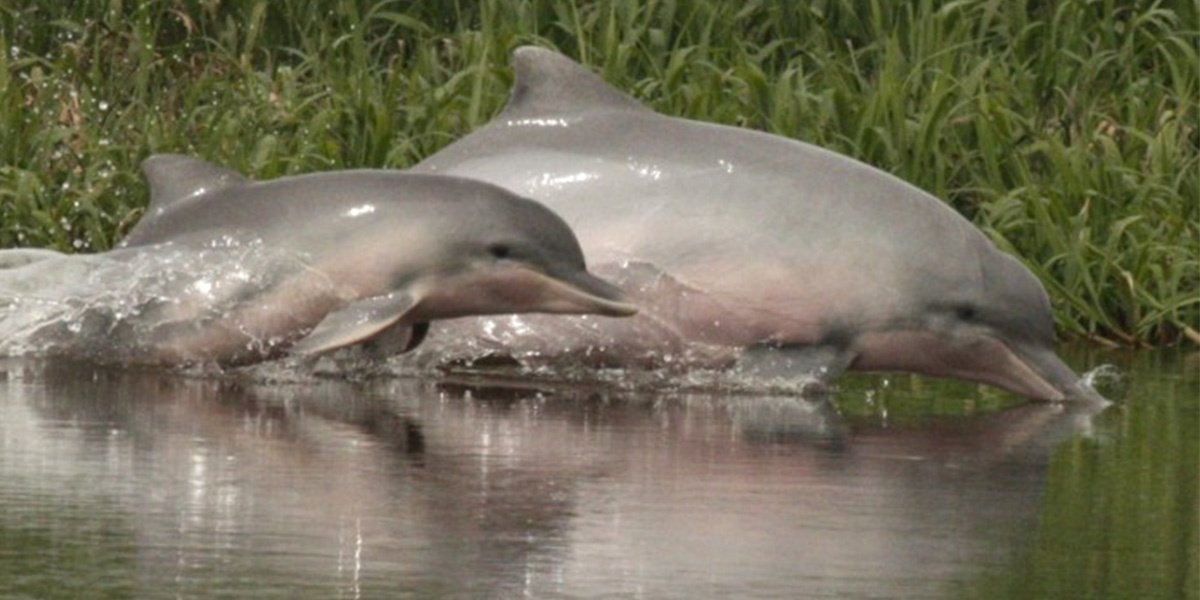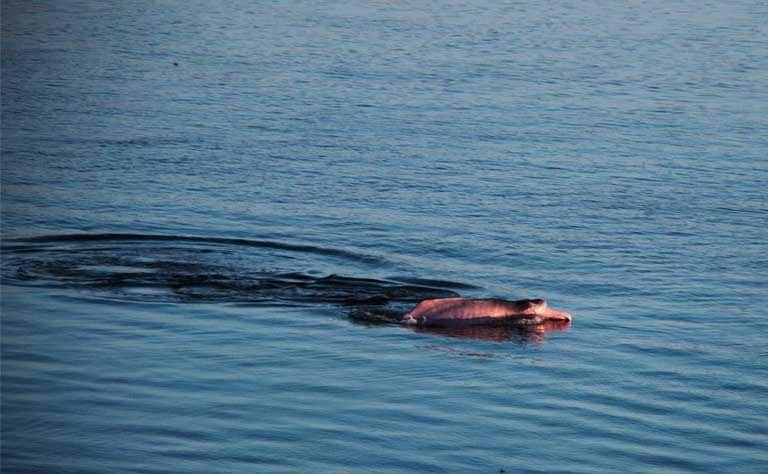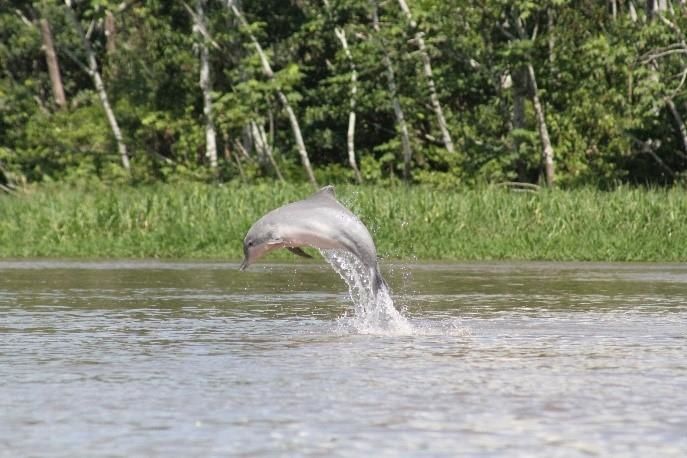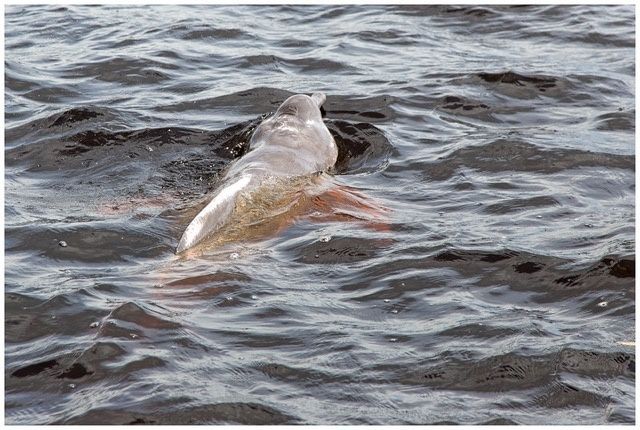

Tucuxi Amazon river dolphins (Sotalia fluviatilis). Projeto Boto
By Claire Asher
Populations of two species of river dolphin in the Amazon are halving every decade, according to the results of a twenty-two year survey.
The Amazon rainforest is home to the Amazon river dolphin, or Boto (Inia geoffrensis) and the Tucuxi (Sotalia fluviatilis). But the results of a long-term study published in PLoS ONE show that both of these once abundant aquatic mammals are now in rapid decline in the Brazilian Amazon, likely due to hunting and fishing.
Vera da Silva from the Instituto Nacional de Pesquisas da Amazônia, in Manaus, Brazil, and colleagues conducted monthly surveys of river dolphins in the Mamirauá Reserve in Amazonas state between 1994 and 2017. They found steep declines in both species over the last two decades, with Boto populations halving every ten years and Tucuxi every nine years—some of the most severe declines seen in cetaceans since the moratorium on commercial whaling came into effect in the 1980s.
“Data from over 22 years of monitoring … revealed a precipitous decline of [Boto] in the last two decades,” said da Silva. “Before 2000, the population was quite stable.”
Boto Amazon river dolphins (Inia geoffrensis). According to researchers, Boto populations are halving every ten years in the study area. Image courtesy of Associação Amigos do Peixe-Boi (AMPA)
The IUCN Red List categorizes both species as “data deficient,” meaning that there is insufficient information to determine their conservation status; the murky waters of the Amazon river make them difficult to study. But the authors say that applying the IUCN Red List Criteria to their data would result in the species being listed as Critically Endangered, having suffered greater than 90 percent declines since 2000 (the Boto declined by 94 percent, and the Tucuxi by 97 percent in the study area, according to the researchers).
“In my opinion, the real importance of this paper is it shows that populations in their study site have a negative growth trend, and [the research] does it with quantitative information,” said Elizabeth Campbell, a conservation scientist at ProDelphinus Peru, a conservation NGO based in Lima, Peru who was not involved in the current research. Although other studies have attempted to estimate population trends for these enigmatic creatures, “this is the only study that has had a constant presence for 20+ years, through different seasons, in [the same] area,” she said.
Finding these illusive creatures requires patience and an eagle eye: “The Botos and Tucuxis come to the surface to breathe every 1-2 min,” explained da Silva, which provides a brief window of opportunity to spot the creatures, before they disappear back into the muddy waters.
The scientist said that when they first began their surveys, the dolphins were plentiful. “When we started our work with these dolphin populations in 1994, we were astonished by the number of animals in the area,” da Silva said. “It was impossible to go out by boat without seeing dolphins.”
A Boto surfaces in the Marañón River, Peru. Difficult to detect in Amazonia’s murky waters, both species are listed as “Data Deficient” by the IUCN. But researchers maintain that if region-wide surveys were conducted both species would end up being listed as Critically Endangered. Clara Ortiz-Alvarez
Over the years, the team not only counted the numbers of dolphins, it also captured and marked some, allowing the researchers to identify individuals in the field. As time passed, they started noticing huge scars from harpoon and machete injuries on the river dolphins they caught. Interviewing local fishermen confirmed the team’s suspicions: “Botos were being hunted for bait, and in large numbers,” said da Silva.
Around the turn of the millenium, catches of commercially important catfish known as Piracatinga or Mota (Calophysus macropterus) in Colombia were shrinking, so new fisheries began to spring up in Brazil to meet market demand.
By 2011, subsistence fishermen had shifted toward becoming commercial fishermen in the Brazilian state of Amazonas, as they hauled in 4.4 million kilograms (9.7 million pounds) of catfish each year. Part of their success could have been due to the bait they used. “They started using caiman meat,” said da Silva, but soon found that Boto carcasses from entanglement with fishing gear were a more effective bait. “Dolphin meat lasted longer and [the catfish] preferred Boto carcasses,” she said.
The supply of accidentally-killed Botos was soon exceeded by demand, and the fishermen started actively hunting them.
River dolphin leaping. Amazon river dolphins had been considered resilient compared to their Asian relatives. But this latest study shows that South America’s river dolphins may also be headed toward oblivion unless action is taken to reduce hunting, fishing and other pressures on both species.F. da Silva VM
The dolphins were abundant at the time, and their high densities in small river inlets and bays, combined with their natural curiosity, made them easy targets, da Silva explained. The Brazilian government placed a five-year moratorium on fishing for piracatinga in 2014, but the practice still continues illegally.
Botos are found throughout both the Amazon and Orinoco river basins. In the wet season, the dolphins leave river channels and swim out into the flooded forests to search for prey among the roots and trunks of partially submerged trees.
Although legally protected in the Amazon, poor enforcement has meant that the species is still routinely entangled in fishermen’s nets and gear, as well as deliberately hunted for fat and blubber. Some fishermen see the dolphins as a nuisance—competing with them for fish and damaging their equipment—and so kill them intentionally. “Fisherman do not like Botos because they damage the fish and the fishing gear,” said da Silva.
In contrast to Boto, the survey showed that Tucuxi have been declining consistently since at least the mid-1990s. Unlike the Botos, Tucuxi don’t enter the flooded forests to feed, but instead stick to the main river channels and tributaries. The species is smaller and faster-moving than the Boto, and is generally considered friendly and not a pest by local fishermen, making it less vulnerable to deliberate hunting. However, gear entanglement remains a serious threat, particularly because fishing nets are often set at the mouths of river channels where the Tucuxi tend to congregate.
Boto swimming in the Rio Amazonas, Brazil in 2016. A lack of political will, drastic cuts to the Brazilian environmental ministry budget, and continued illegal dolphin hunting and fishing are putting these aquatic mammals at risk.Martha de Jong-Lantink on Visualhunt.com / CC BY-NC-ND
The decline of both species is significant for aquatic ecology. River dolphins are a key part of the Amazonian ecosystem—Botos are known to feed on 43 different species of fish, most of which live near the river bottom, while Tucuxis feed on at least 28 species, mostly small schooling fish found higher in the water column. Many of these fish are commercially exploited, too, putting the dolphins in direct competition with local fishermen.
“The takeaway message for me is that fisheries interaction with river dolphins is probably the most significant threat these species face,” said Campbell, adding that “populations are decreasing faster than we could expect.”
Mamirauá Sustainable Development Reserve, where the study was conducted, is a 4,300 square-mile (11,000 square-kilometer) protected area—one of the largest in the Brazilian Amazon. Within the reserve, where commercial fishing is banned, mortality of dolphins is primarily the result of accidental deaths from subsistence fishing. However, some Botos travel up to hundreds of kilometers, straying outside the reserve where they may encounter other threats, including direct hunting, commercial fishing gear and pollution from agricultural run-off and mining.
One danger: toxic mercury, often used in mining to separate gold from soil and rock, accumulates in river sediments and can cause problems for top predators, like river dolphins, that consume large quantities of pollutants in the fish they prey on. The mercury bio-accumulates in increasing, eventually deadly, amounts in the dolphins’ fat.
Amazon river dolphins had been considered resilient compared to their Asian relatives, the endangered Ganges river dolphin (Platanista gangetica) and the critically endangered Baiji (Lipotes vexillifer), which many conservationists believe may be extinct in the wild. Da Silva and colleagues’ latest study shows that South America’s river dolphins may also be headed toward oblivion.
Tucuxi swimming. Brazil’s struggling economy means that fishermen are likely to try to increase their catches, even if that means illegally using dolphins for bait, or killing them either by accident or intentionally.Mike LaB on Visualhunt / CC BY-NC-ND
If Amazon basin dolphins are to survive, the Brazilian government needs to take the first step of strengthening existing protections and improving enforcement, da Silva said. “Controlling the fisheries catching catfish and preventing fishermen setting nets at the entrances of rivers, lakes and channels,” would be a good start, she said.
Implementing dolphin protections and preventing illegal hunting in the flooded forests of the Amazon would be challenging, but is possible, da Silva said. But Brazil’s environment ministry has seen draconian budget cuts (51 percent in 2017 alone) under the Temer administration, so it lacks the staff, equipment and fuel needed to monitor remote Amazonian regions. And as in many countries, there is currently a lack of political will to pass and enforce strong environmental legislation. Meanwhile, Brazil’s struggling economy means that fishermen are likely to try to increase their catches, even if that means illegally using dolphins for bait, or killing them either by accident or intentionally.
“Fisheries in the Brazilian Amazon are not well controlled and quantified,” da Silva said. And there is no sign that that reality will change soon.
381 New Species Discovered in the Amazon https://t.co/F6QdYJVfaZ @ConservationOrg @AusConservation
— EcoWatch (@EcoWatch) September 2, 2017
Reposted with permission from our media associate Mongabay.
- First Ever Tagging of Amazon Dolphins to Boost Conservation Efforts
- Brazil's Amazon River Dolphin Faces Extinction After Fishing Moratorium Ends

 233k
233k  41k
41k  Subscribe
Subscribe 




